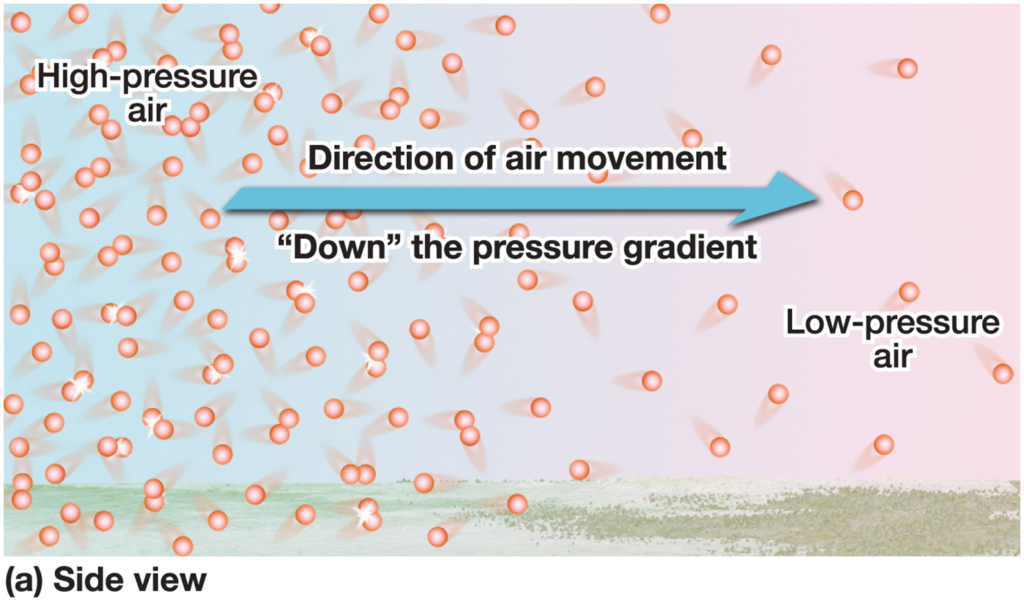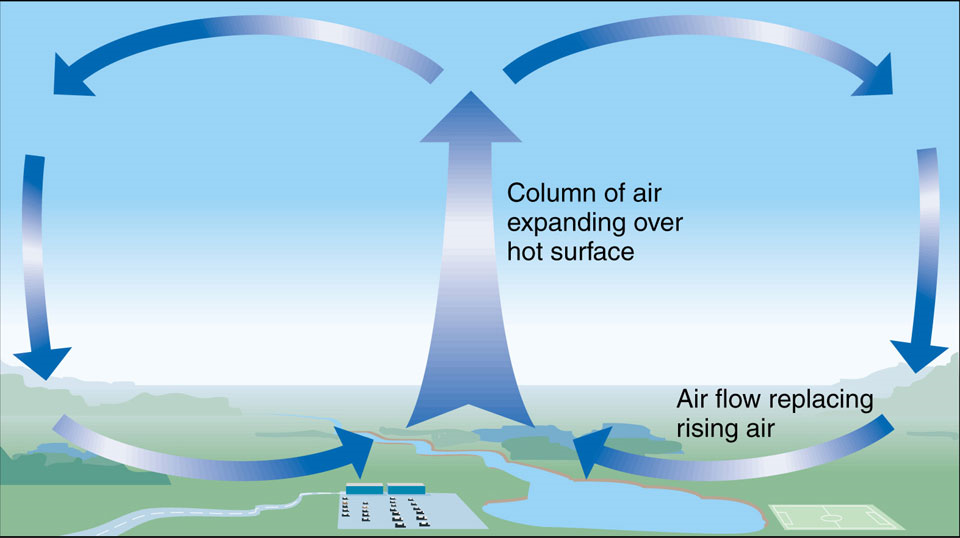Main Body
Chapter 5
Topic 5 – Hot Air Rises (Atmospheric Temperature and Circulation)
One of the most important relationships under normal conditions in the atmosphere is that pressure decreases upwards through the atmosphere. This relationship drives a significant amount of global circulation and weather patterns. But why does hot air specifically rise and cool in the atmosphere? It has to do with the Earth’s relationship to the Sun and the density of warm air, and that air always moves from areas of high to low pressure, following the pressure gradient.
Recall from our overview of the atmosphere, that in the Troposphere (the atmospheric layer closest to the Earth’s surface), temperature is highest at the surface and decreases upwards. This is because incoming solar radiation heats the surface of the Earth and that heat energy is re-radiated to the lowest parts of the atmosphere most efficiently. It warms the air just above the surface of the Earth. As this air warms, the particles become more energetic and push outwards, expanding the air mass and resulting in fewer particles of air in the same volume of space (a decrease in air density). As an air mass decreases in density with respect to surrounding air, it starts to rise.

An air mass will continue to rise until it equals in density to the air surrounding it. Usually this happens because as an air mass rises, it is exposed to cooler air, and it starts to lose some of its heat energy. But there is another physical process at work here, referred to as adiabatic temperature changes. See how Wyoming mountains illustrate adiabatic heating and cooling here: https://www.youtube.com/watch?v=XH_M4jItiKw.
Adiabatic changes in temperature occur without any external change in heat energy exchange, but instead are driven by internal changes in how kinetic energy is distributed through an air mass. Remember that temperature is a measure of the average kinetic energy in a system. If you take a warm air mass of small volume at the Earth’s surface and move it upwards in the atmosphere, it expands to greater volume as it rises, a natural outcome of reaching areas of lower atmospheric pressure. As it expands, the same particles, with the same kinetic energy now occupy a larger volume. The average kinetic energy of the system has decreased…and so has the temperature, without any change in external heat transfer. In this way, air masses naturally decrease in temperature as they rise. An example of adiabatic change here: http://agron-www.agron.iastate.edu/courses/Agron541/classes/541/lesson06b/6b.6.html
As you might imagine, air masses that are colder than surrounding air are more dense and tend to sink. This vertical movement of air (upwards and downwards) due to density differences is called convection. Convection drives the movement of air throughout our atmosphere and it is linked to the horizontal movement of air, called advection. Together, convection and advection create large atmospheric movements called convection currents.
Locally, this pattern may occur as the Sun’s rays strike a part of the Earth’s surface in the morning, warming it and causing rising air over a small area. Globally, this pattern is in almost constant operation, as solar energy is focused over the equatorial regions between the tropics, resulting in consistent, rising air over the equator. As this air rises, it creates a low pressure space beneath it where new air rushes in to replace it. This air is supplied by sinking (colder) air masses over areas north and south of the equator at about 30° latitude. So a cycle of air, rising over the equator, diverging to flow north and south, and then descending to the Earth to flow back to the equator, is formed. This cycle of air is called the Hadley Cell, and it exists in a nearly constant state year round. See how global circulation works here: https://www.youtube.com/watch?v=xqM83_og1Fc&t=60s

On average, around the globe, atmospheric pressure at sea level is about 101.3 kiloPascals (kPa). But this is an average, and is generally not the actual pressure at any given time for any given location on the Earth’s surface. Atmospheric pressure is defined in part, by the density of the air column above that point. A low density air column will rise, yielding low pressure below it. A high density air column will sink, resulting in higher pressure below it. Therefore, warmer air usually corresponds with low pressure air masses and colder air usually corresponds with high pressure air masses. These high and low pressure air masses are the starting point to understanding the development and interaction of weather systems.
rate of change of pressure over a certain distance (usually is denoted in mb/km) (IowaState University)
The change in pressure measured across a given distance (UIUC online ed)
large body of air with shared temperature and humidity characteristics associated with its area of origin e.g. maritime or continental; tropical or polar (ItsEducation)
A body of air whose temperature and humidity characteristics remain relatively constant over a horizontal distance of hundreds to thousands of kilometers (PhysGeo.net)
A process in which heat does not enter or leave a system. adiabatic processes are often used to model internal energy changes in rising and descending parcels of air in the atmosphere (PhysGeo.net)
change in temperature due to expansion or contraction of a parcel of air which thus change the pressure and therefore the temperature (ItsEducation)
involves the transfer of heat energy by means of vertical mass motions through a medium (PhysGeo)
transfer of heat in a gas or liquid by upward movement of the hotter, less dense portion. (ItsEducation)
The process of transport of an atmospheric property solely by the mass motion (velocity field) of the atmosphere (AMS)
horizontal transfer of heat by a horizontally moving air mass (ItsEdu)
A direct thermally driven and zonally symmetric circulation under the strong influence of the earth's rotation (AMS)
portion of the tricellular model of air circulation where air rises at the equator due to convection, spreads in the upper troposphere and then sinks over the tropics before returning to the equator. (ItsEdu)
